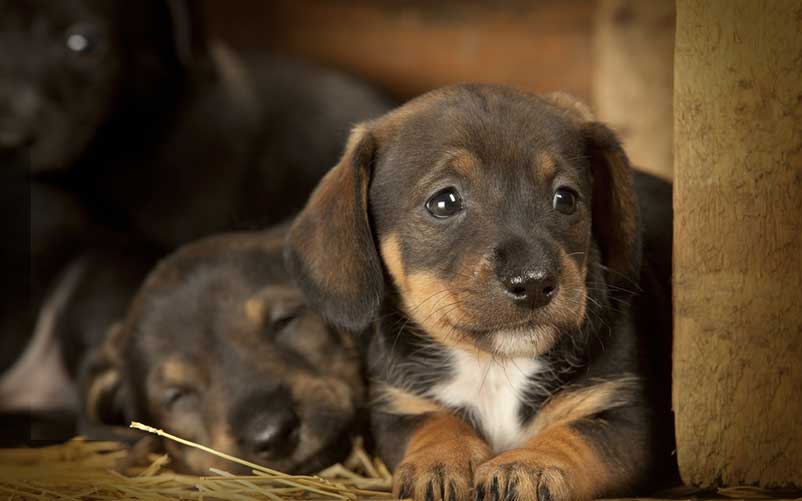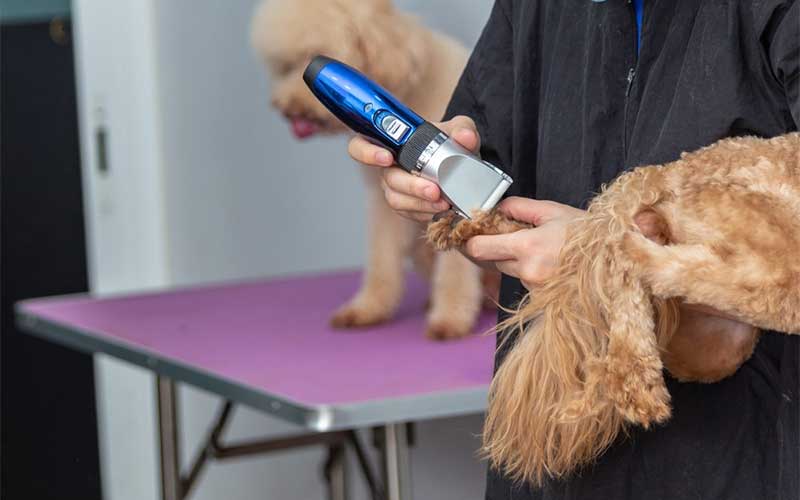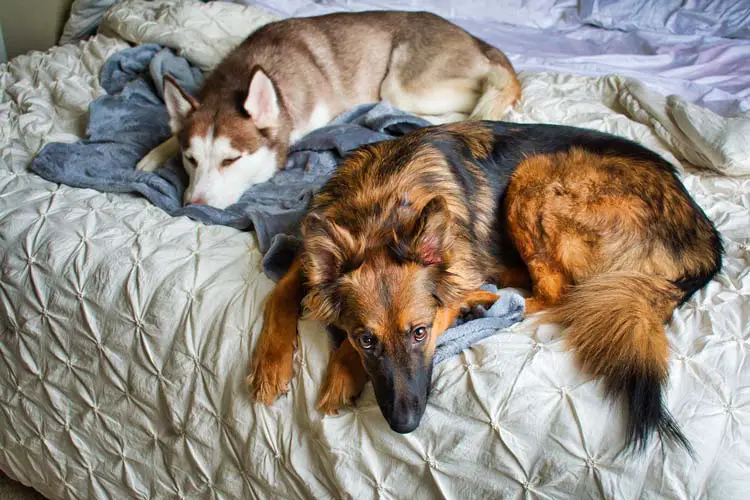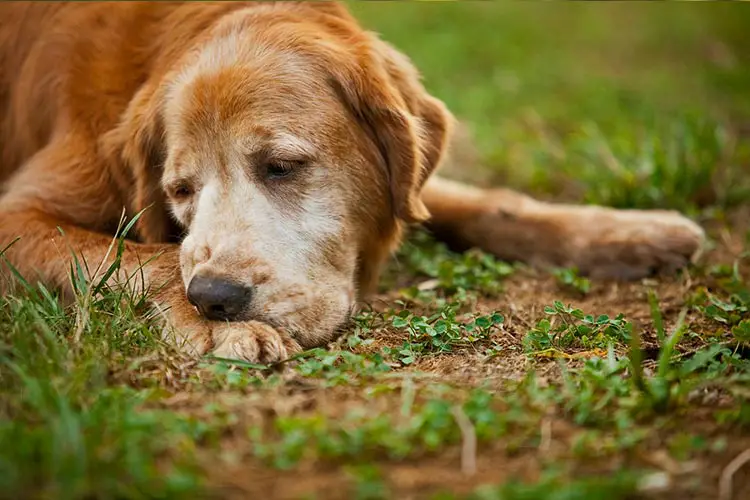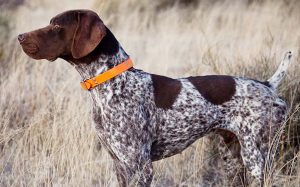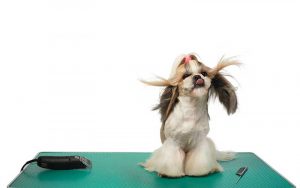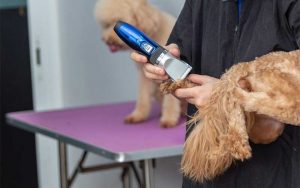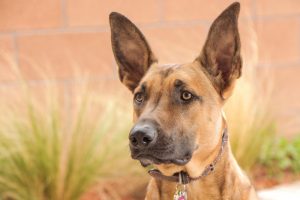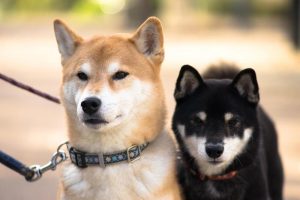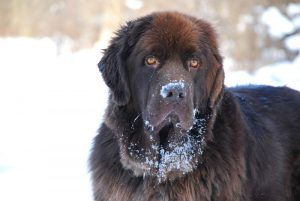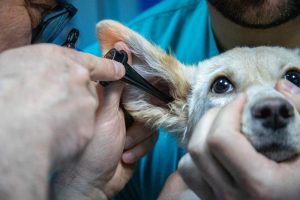
Page Contents
When does Newfoundland Stop Growing?
A Newfoundland will typically reach their adult height and weight at 24 months or 2 years old. With that said, Newfies might also get bigger after their adulthood compared to other dog breeds. The growth rate, however, may differ depending on genetics and the food you choose to give to them.
This big yet cuddly breed, when fully grown, is not only attractive but can also be a great companion for life. As long as you keep them fed with a well-balanced diet and maintain their lean build, they will grow normally and healthily with fewer instances of getting sick.
How big can Newfoundland get?
When your Newfoundland dog is fully-grown, expect them to be around 100 to 120 pounds for females and 130 to 150 pounds for males. Generally, they could be around 28 to 28 inches in overall height or length.
See also:
What is the size of a full-grown Newfoundland dog?
Male Newfoundland dogs can range from 27 to 29 inches while females will be around 25 to 27 inches. Female Newfoundland dogs can weigh around 100 to 120 pounds while males are around 130 to 150 pounds. These weight ranges are officially recognized by the AKC (American Kennel Club).
Newfoundland Growth & Weight Chart – What to Expect
To help you figure out what to expect from a Newfoundland dog, below is a weight chart, as well as tips on feeding your newfoundland while they are still young:
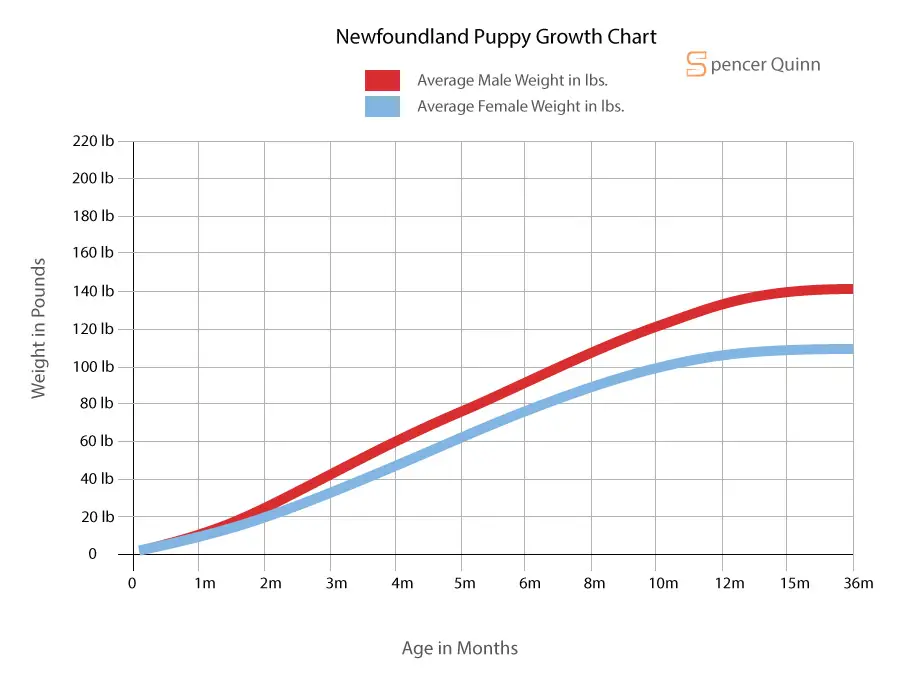
| Age of Newfoundland dog | 1 to 3 months | 4 to 6 months | 7 to 9 months | 10 to 12 months | 2 years old |
| Male weight (pounds) | 8 to 54 | 57 to 87 | 82 to 114 | 109 to 130 | 130 to 150 |
| Female weight (pounds) | 7 to 46 | 45 to 71 | 66 to 84 | 83 to 106 | 100 to 120 |
As you can see above, Newfoundland dogs can get big quite fast, which means you’ll need to stock up on food at home. A Newfoundland is a big dog breed so it’s likely that they need more nutrition for their breed size and age. Here’s what to expect from their growth and weight:
Birth to 3 weeks
During their first few weeks, they will need to be nursed by the mother. Newfies are still young and cannot open their eyes just yet. For puppies that cannot feed their mother, they might need a puppy formula as recommended by your veterinarian.
4-6 weeks
A Newfoundland puppy can start the weaning process by this time. Try mixing a puppy formula made of water and solid puppy food, which is suitable for their age and breed. The water should be high in ratio at first.
Don’t feel bad if the Newfoundland puppies don’t eat it at first. Weaning is typically a long process and even the mother will help you out. She will slowly walk away from the puppies as the weeks come by. Continue offering the food until you can slowly decrease the amount of water in the bowl.
8-12 weeks
When your Newfoundland puppy turns 8 weeks old, it can be re-homed or adopted. If you are the breeder, make sure you tell the new owner all about the food they eat, their habits, and all other important information regarding their health and behavior.
If you are the person who will adopt a Newfie, however, make sure you ask all the important questions to ensure that your Newfoundland puppy gets the right nutrition. If you need to switch food brands, always do the portioning gradually to avoid stomach upsets.
Some experts, however, suggest that adopting a Newfoundland puppy is best done by the 10th week, although this depends on a variety of factors, such as the maturity and independence of your chosen Newfoundland pup.
3-4 months
By this time, your puppy should be slowly eating the solid food without water in the mix. Once your pup can already eat solids, they are less likely to be nursed by the mother and they will be fully independent. However, each Newfie pup can be different from the others in terms of development.
A 4-month-old Newfoundland puppy should be somehow separated from its mother or at least independent. Despite their size as a large breed, they can still be puppies from time to time due to their playful nature.
6-8 months
The good news about Newfies is that they aren’t as destructive as other dog breeds. They tend to be on the sensitive and calm side so they likely won’t chew your carpets and shoes unless something caused them to feel stressed.
If for some reason, your Newfoundland puppy is difficult to handle in terms of behavior, you may want to enroll them in obedience classes and the like. This is also important if you don’t have a lot of experience with puppy training.
10-12 months
During this time, your Newfoundland might have already become crazy big, which is why you will still need to maintain a healthy balance of diet and exercise. With that said, don’t tire your Newfie with long walks because they might get some joint and bone problems later on.
While going around the yard is fine, always make sure that someone is watching over them. The Newfoundland puppy will still grow by this period, albeit slower. A 5-minute walk or workout should be fine for your Newfie pup.
Fully-grown
A Newfoundland will become an adult once they’ve turned 2 years old. Their size will vary depending on their gender, genetics, food, and other factors. Since Newfies are big dogs, it can be tempting to call them adults while they are still below 2 years of age, but that shouldn’t be the case.
As a large breed, Newfies should be trained gently. Most experts advise more on intelligence rather than physical training. With that said, don’t make them too overweight either by balancing out physical activity and food intake. You can also ask your vet for some tips on how to maintain your Newfie’s weight.
Great Dane vs. Newfoundland Size Comparison
The Newfoundland dog has an average height of 28 inches, which is shorter than the height of the Great Dane, which averages about 32 inches. Aside from that, the Great Dane even has longer ears and a more upright head, making it seem like it’s even taller than Newfoundland dogs.
With that said, Great Danes have a less bulky build, especially when it comes to coat length. This is where a Newfoundland dog shines due to its fluffy and bulky appearance. If you look at the height, however, Newfies are still smaller than Great Danes.
On the weight of the breeds, Great Danes weigh around 140 to 175 pounds while Newfoundland dogs are only around 130 to 150 pounds. Even when it comes to weight, the Great Danes outweigh (pun intended) the competition. However, this still depends on various factors, such as genetics and food.
Newfoundland vs. Saint Bernard Size Comparison
The Saint Bernard dog has an average weight range of 120 to 180 pounds, which is slightly bigger than that of a Newfoundland dogs’ weight bracket of 100 to 150 pounds. Even with such information, people would think that they have the same weight and size since the difference is quite small.
When it comes to height, Saint Bernard dogs have a height range of 26 to 30 inches, which is just slightly taller than the Newfoundland dog, which ranges from 25 to 29 inches when it comes to their average adult height. Again, the difference between these two breeds in height is also not that distinguishable.
What Affect the Size of a Newfoundland?
Not all Newfoundlands grow the same way, so why are some Newfies bigger than the others? What affects the size of a Newfoundland dog when they grow up? Here are some possible factors:
Food and nutrition
Choosing the right kind of food for your Newfoundland will always make a huge percentage of their growth rate and overall health. If you feed your puppy with the right nutritious food without additional fillers, they will grow strong and healthy.
If you think that your Newfie is too small or too big for their age based on the chart we mentioned above, you may want to discuss it with your vet. They might give you some pointers and diet plan suggestions to help your Newfoundland get the ideal and healthy weight.
Genetics
Like humans, dogs can adapt to the traits of their parents and relatives as well. While it is given that Newfoundland dogs are a large breed, there are instances where certain dogs of the said breed are much larger than the average type.
If you want to know how big your Newfoundland puppy will become, you might want to start looking at their parents. This is why it pays to visit the breeder and ask about the parents so that you’ll know if your Newfie pup will tend to grow bigger than most of their kind.
In some rare cases, a Newfoundland puppy might also grow slower than others, similar to what we call a late bloomer in humans. Don’t worry – they will still grow normally so long as you keep them well-fed with the right kind of food with proper scheduling and exercise.
Physical Activity
While we did say that physical activity should not be too vigorous for Newfies, it is still needed for them to maintain their overall health and weight. As big dogs, they can still be prone to obesity if they are not fed and exercised properly.
During puppyhood, Newfoundland dogs should have enough space to roam around, but make sure it’s safe for them to play around there. Consider less vigorous exercises and don’t encourage them to play or walk longer than 5 minutes to avoid stress.
The Newfoundland dog is prone to a wide range of joint-related problems, such as hip dysplasia, elbow dysplasia, and Osteochondrosis Dissecans. That’s expected of large breeds and that’s why you should be more careful when exercising your dog to avoid straining their joints at a young age.
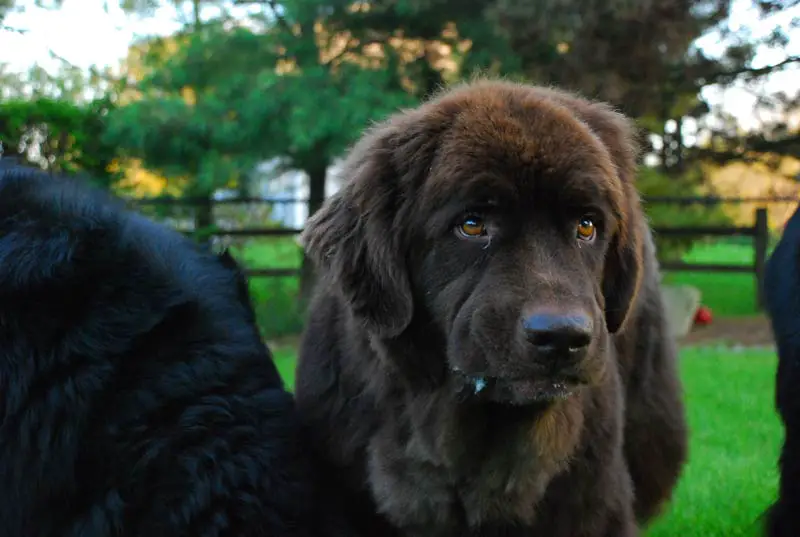
How do I make sure my Newfoundland is healthy?
To keep your Newfoundland dog healthy and happy, here’s what you need to do:
1. Exercise regularly and properly
As mentioned above, exercise is important for Newfoundland dogs to maintain their normal weight. However, make sure that it’s not too strenuous so that the dog or puppy will not develop joint problems later on. After all, big dogs like the Newfoundland dog will be prone to hip and elbow dysplasia.
The exercise or physical activity should not be more than five minutes and should not be done on the very solid or concrete ground. Instead, have them roll around on the grass so that it won’t take a toll on their joints and bones.
2. Keep the dog in a cool place
The Newfoundland is a fluffy dog and they need a lot of cooling to keep them ventilated and comfortable. Due to their thick coat, they should be in an area with a sufficient amount of coolness, such as in a room with air conditioning.
If the weather is too hot outside, you should refrain from bringing your Newfoundland dog outdoors and keep them cool inside the house. You can take them for a walk only for a short time and only when the sun is not too hot or intense.
3. Schedule feeding
Like all dogs, the Newfoundland dog will get obese if you feed them too much. Learn to schedule feeding so that they don’t eat excessively for their age and ideal weight. If you can’t get someone to feed your Newfie at home, why not try an automatic feeding scheduling machine?
Not only will your Newfoundland have a regularized appetite but it will also help to reduce begging and other food-related bad behaviors.
4. Talk to your vet
If you spot something that’s not right with your Newfoundland, such as not reaching the ideal weight, you can talk to your vet. They will give you some tips on how to catch up your dog to the ideal size and the foods you can give to your canine friend safely.
What’s more, veterinarians know the best when it comes to nutrition and routines that your dog might lack. For example, they might also advise your dog to get groomed if their coat grows fast, which will help to eliminate skin allergies.
Newfoundland Common Health Problems
As a large breed, the Newfoundland is also prone to a wide range of health issues, such as the following:
Hip and elbow dysplasia
As mentioned above, Newfoundland dogs are prone to hip and elbow dysplasia since they are a large breed, which is typically prone to joint problems. To diagnose hip and elbow dysplasia, X-ray screening is often needed. If this happens to your dog, talk to your vet right away.
Breeders will also strongly advise against breeding Newfoundland dogs with dysplasia to avoid passing on the genes to the offspring. If your dog ends up having dysplasia, however, it can be treated by surgery. Your vet might also prescribe medication if the dog can’t be operated on yet.
Gastric Torsion
Characterized by feeling restless, too much drooling, and having trouble when eating a large meal, gastric torsion, also known as bloat, can be fatal to your Newfoundland if not treated or managed properly. Make sure to get your dog to the vet if these symptoms show up.
The reason why Newfoundland dogs get gastric torsion is due to their wide and deep chest. Most large breeds also tend to have bloat, which is why they need to be fed in schedules and only a specific amount of food to avoid gobbling their food.
Eye problems
Cherry eye and cataracts are among the two most common eye problems that a Newfoundland dog can have. This is why vitamin A is important as a part of your dog’s diet. To help lessen the likelihood of eye problems, consider getting your dog from a reputable breeder.
Such eye problems can be treated with surgery as advised by your veterinarian. The surgery will take quite a while to heal, however.
Hypothyroidism
Newfoundland dogs can get hypothyroidism, which is hereditary. They have an abnormal thyroid gland if they have this health condition and it could lead to a variety of problems, such as poor weight management, epilepsy, skin problems, lethargy, and more.
Your vet might also advise getting your dog screened for hypothyroidism. They will also prescribe medications and other forms of treatment for your dog.
What If My Newfoundland is Not the Right Weight?
If you’ve consulted the chart above, there’s a chance that your Newfie might not be in the ideal weight, but don’t panic just yet. To avoid getting an improper weight for your Newfoundland dog, here’s what you can do:
- Maintain a balance of exercise and a good diet
- Plan your meals and schedule properly
- Don’t be in a rush to make your dog lose weight
- Watch the calorie intake of your dog
How to Help a Newfoundland Lose Weight
Weight loss for a Newfoundland dog should be done slowly to avoid hurting their joints. As mentioned above, the breed is prone to hip dysplasia because of being a large breed. Therefore, don’t give them too many stressful activities all at once.
Gradually increase the walking and other physical activities per day. Couple the physical activity with good food choices as advised by your vet. Make sure to include healthy options and ingredients for their daily meals. These will help your Newfoundland to lose weight healthily.
How Much Does It Cost To Own A Newfoundland?
The typical price range of a Newfoundland dog is $1,500 to $2,000 depending on where you live and the breeder you will get it from. As big dogs, they need a lot of maintenance (e.g. food and grooming), which is what makes them pricier.
Adopting a Newfoundland is fairly cheaper at only around $300 so if you are more of an “adopt, don’t shop” pet owner, consider adoption as an alternative.
Q&A
The typical lifespan of a Newfoundland dog is from 8 to 10 years. However, this range will depend on a variety of factors, such as health, food, lifestyle, and the care that their owner gives to them. Frequent trips to the vet and good food will contribute to more years.
The biggest Newfoundland dog ever recorded in history was at 260 pounds and towering at 6 feet from end to end. With that said, most Newfoundland dogs can go over 200 pounds if they have certain genetics and nutrition.
Expect a Newfoundland dog to get pregnant starting at 18 months of age. This is the best time to breed your Newfie to avoid getting problems like dysplasia, which can be caused by hormonal changes during pregnancy.
A litter of Newfoundland puppies on a single pregnancy can be around 8 to 10. However, on rare occasions, there could even be just 2 puppies, especially with younger pregnancies, or as many as 15. Genetics, food, and other factors can affect the size of the litter.
Newfoundland dogs should have a collar size of 26 to 32 inches depending on their age, size, height, and weight. Always measure your dog’s collar to avoid making it feel uncomfortable for them.
A good size dog crate to start with for a Newfoundland dog is 48 inches. However, you can also settle for a 42 x 36-inch crate for your Newfie, especially if you don’t have a lot of space at home.
As a large breed, a Newfoundland dog should have at least 54 inches when it comes to getting a dog bed. Make sure that it has sufficient room for them to stretch and sleep properly.
